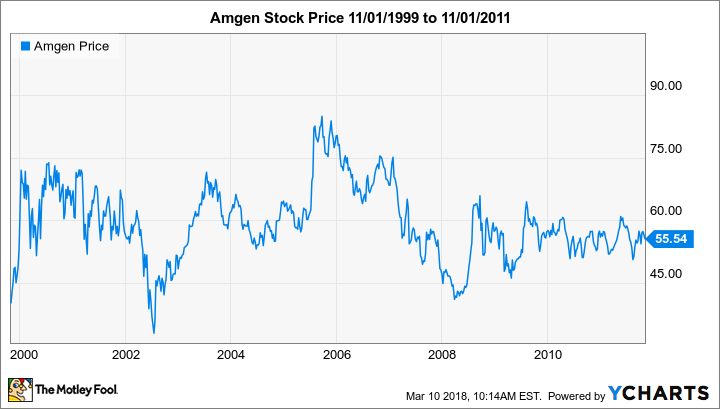Healthcare giant Amgen (AMGN 0.45%) has been cranking out life-saving medicines for almost four decades, which makes it one of the oldest biotechnology companies in existence. The company has successfully introduced a number of blockbuster drugs to market over the years including winners like the anemia drug Epogen, the white blood cell boosting drug Neupogen, and the rheumatoid arthritis Enbrel.
Amgen's knack for launching top-selling drugs allowed its financial statements to flourish over the years. Wall Street cheered on the prosperity by pushing its stock price to regular new highs, especially during the 1990s. In response, Amgen decided to split its stock on numerous occasions:
|
Date of Split |
Stock Split |
100 Shares in 1980 Would Now Be |
|---|---|---|
|
Aug 13, 1990 |
2 for 1 |
200 shares |
|
Sep 11, 1991 |
3 for 1 |
600 shares |
|
Aug 16, 1995 |
2 for 1 |
1,200 shares |
|
Mar 01, 1999 |
2 for 1 |
2,400 shares |
|
Nov 22, 1999 |
2 for 1 |
4,800 shares |
DATA SOURCE: YAHOO! FINANCE.
Do stock splits matter?
A few decades ago it was hard for brokers to trade in odd lots -- meaning any order between 1 share to 99 shares. The most desirable trading unit was 100 shares, which was called a round lot. This trading nuance provided companies with an incentive to split their stock since doing so would lower their share price and make it easier for investors to buy and sell in blocks of 100.

Image source: Getty Images.
However, the move toward electronic trading made it much easier for investors to trade in odd lots over time. As a result, companies tend to not split their stock as often as they once did.
Why haven't Amgen's shares split recently?
It has been about 19 years since Amgen last split its stock. The long gap is largely explainable by two factors.
The primary reason is attributable to Wall Street's de-emphasis on trading in odd lots. Since investors can now easily buy and sell a few shares at a time, Amgen hasn't felt pressured to reduce its share price, even as its stock has continued to hit new highs in recent years.
Another factor that is worth highlighting is Amgen's lofty valuation around the time of its last split. In the early 2000s, Amgen was trading for more than 72 times earnings at its peak, which is a premium price tag. That rich valuation is one reason why Amgen's stock largely traded sideways for more than 12 straight years following the turn of the century, which negated the need for the company to perform a split.
Will Amgen split its stock again?
It's possible. Amgen's stock has thumped the S&P 500 over the last decade and is currently trading within a few dollars of $200 per share. If the stock continues to appreciate from here then the company's board of directors might eventually fell compelled to split its shares once again. However, since stock splits neither create nor destroy shareholder value, potential investors shouldn't factor a potential split into their decision to purchase shares or not.
What's next for Amgen?
While Amgen's performance since the end of the Great Recession has been strong, the stock price has underperformed the market in the last few years. One reason for the underperformance is that sales of the company's legacy drugs -- Enbrel, Neulasta, and Epogen -- are waning. Thankfully, the company has a number of next-generation drugs that have been picking up the slack and should allow profits to grow.
One of those up and coming drugs for investors to watch is Prolia, which is a treatment for osteoporosis. Sales of Prolia jumped 20% last year to just shy of $2 billion. The company believes there is still plenty of room left for this drug to run.
Another potential homerun drug in the making is Repatha, which helps to lower LDL cholesterol levels (that's the bad kind of cholesterol). While Repatha's sales have been disappointing thus far, that could change thanks to the recent release of long-term clinical data that showed taking these types of drugs leads to positive cardiovascular outcomes. That data could entice more doctors to give these drugs a try and also loosen up payer pursestrings.
Amgen's pipeline should also provide investors with reason for optimism. The company is currently pending FDA approval for a new migraine treatment called Aimovig that, if approved, could provide its top-line with a boost. Amgen also has a number of biosimilars drug candidates in development that could make the company a major player in a growth industry.
In total, Amgen's newest crop of drugs and pipeline should help offset weakness in its legacy products. When combined with margin gains and stock buybacks, Amgen's earnings should be able to grow at a moderate pace from here. Adding in the company's growing dividend and modest valuation makes me think this stock is set up for long-term outperformance.







